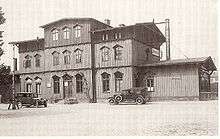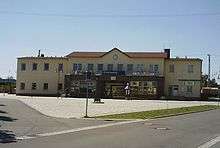Elsterwerda railway station
| Junction station | |
 Exterior view of the station | |
| Location |
Am Bahnhof 1, Elsterwerda, Brandenburg Germany |
| Coordinates | 51°27′37″N 13°30′59″E / 51.46028°N 13.51639°ECoordinates: 51°27′37″N 13°30′59″E / 51.46028°N 13.51639°E |
| Line(s) |
|
| Platforms | 3 |
| Tracks | 7 |
| Other information | |
| Station code | 1569[1] |
| DS100 code | BEW[2] |
| IBNR | 8010099 |
| Category | 4[1] |
| Website | www.bahnhof.de |
| History | |
| Opened | 17 June 1875 |
| Traffic | |
| Passengers | < 2,500/day |
Elsterwerda station is in the town of Elsterwerda in the German state of Brandenburg. It lies on the Berlin–Dresden railway. The station is known for a train crash in 1997, when a freight train with 22 petrol tankers derailed and exploded on the station premises.
Infrastructure
The station has had three platform edges since its reconstruction in the 1990s:
- the main platform next to the station building, which is 300 m long and 55 cm high,
- an island platform, which is 300 m long and 38 cm high.
An underpass that is reached by stairs connects the island platform with the main platform.
History
Friedrich Jage, a master mason and later an honorary citizen of Elsterwerda, built the then three-storey station building according to the specifications of the Berlin-Dresden Railway Company (Berlin-Dresdener Eisenbahn-Gesellschaft) in "American"-style timber construction. The station was opened with the Berlin-Dresden railway on 17 June 1875 without a public opening ceremony. The first railway station master was a Mr Bruttloff. Excursion trains ran from Berlin to Dresden for an industrial exhibition on 10 and 17 July 1875. The 22 kilometre-long Riesa–Elsterwerda railway was opened on 15 October 1875.
In the following years, the railway became one of the strongest economic enterprises of the city and due to the good rail connections several industrial companies settled in Elsterwerda and nearby Biehla, causing significant population growth. The population increased from 1,739 in 1871 to 2,537 in 1895 and 4,224 in 1910.


A highlight of the station was a visit by Wilhelm II, German Emperor on a special train on 27 August 1888, which stopped for about ten minutes at the station.
There was a proposal in March 1894 for the construction of a railway line from Elsterwerda to Kamenz, but this was never realised, like many other railway projects at that time.
Because the station was a border station between Prussia and Saxony, the operation of the station was shared between Prussian and Saxon officials. According to a personnel list of 21 November 1912, 129 Prussian and 24 Saxon railwaymen were employed in the station’s freight facilities. It was later said in the town that the Prussian and Saxon officials threw inkwells during disputes.
In 1914, there were plans to build a railway line from Burxdorf via Elsterwerda to Ortrand and preliminary talks were held to promote the sale of the shares of the proposed company. This project eventually failed at the end of the 1920s.
The first air raids on Elsterwerda were carried out by the Allies in April 1945 and the town was attacked by low-flying aircraft. The station and its facilities were bombed on 19 April 1945. An ammunition train that was stopped in the station was hit, caused explosions that caused severe damage on the railway premises and to the centre of the town. The upper storey of the station building was badly damaged and it was not subsequently rebuilt.
After the end of the Second World War, clean-up and repair work on the railway premises soon began and so on 11 May 1945, the first train ran from the bridge over the Elbe in Niederwartha near Dresden via Elsterwerda to Berlin. As early as July 1945, 210 railwaymen were employed in Elsterwerda. Later, the administration of Elsterwerda station, which included the Elsterwerda locomotive depot and Elsterwerda-Biehla station, employed about 1,000 railway workers.
After the reunification of Germany, there were radical changes at the Elsterwerda precinct and it lost its significance. The locomotive depot was closed and the operation of locomotives was moved to other locations. A similar fate also affected the track maintenance operations. Employees were dismissed or transferred. The station building was reconstructed from 1988 to 1991, receiving a completely different look. The new station layout was completed in March 1992.

There was a serious accident affecting the entire station area and the adjacent depot on 20 November 1997, when a freight train with 22 petrol-filled tank cars derailed at a set of points. Two ensuing explosions of the wagons caused severe damage to the station building and the precinct. Two firefighters were killed in the subsequent unloading operations and several others had to be treated for burns in hospital. A memorial stone was later erected in their honour in the grounds of the station.
The heavily damaged engine shed was later demolished and never rebuilt. The substantially damaged station building was renovated. Petrol seeped into the soil during the disaster and even after ten years it is still being filtered out of the ground.
In 2004, the station forecourt was completely rebuilt. Several of the buildings in this area were demolished and replaced by greenery and platforms for the bus station. The new works were formally inaugurated on 5 August 2004.
A siding runs from the station into the industrial area of Elsterwerda-West and there is also a container terminal.
Prospects
From mid-2014 until mid-2015, 3.6 km of track and seven sets of points at the station are being renewed, the pedestrian underpass is being rebuilt with two lifts and a new 320 m long island platform is being built, while other tracks and sets are being dismantled.[3]
Between June 2014 and June 2016, it is intended that an electronic interlocking will be built for the Elsterwerda and Hohenleipisch area.[4] Signalling on the 6 km-long section is to be replaced by the end of 2016.[5]
Rail services
The following services currently call at the station:[6]
| Preceding station | DB Fernverkehr | Following station | ||
|---|---|---|---|---|
| EuroCity | toward Budapest |
|||
| Preceding station | DB Regio | Following station | ||
| RE 5 | Terminus | |||
Elsterwerda-Biehla
Terminus | RB 31 | Prösen Ost
toward Dresden Hbf |
||
| Preceding station | Mitteldeutsche Regiobahn | Following station | ||
| Terminus | RB 45 | Prösen
toward Chemnitz Hbf |
See also
Notes
- 1 2 "Stationspreisliste 2016" [Station price list 2016] (PDF) (in German). DB Station&Service. 1 December 2015. Retrieved 24 January 2016.
- ↑ Eisenbahnatlas Deutschland (German railway atlas) (2009/2010 ed.). Schweers + Wall. 2009. ISBN 978-3-89494-139-0.
- ↑ "Deutschland-Frankfurt am Main: Bauarbeiten für Eisenbahnlinien". TED (Tenders Electronic Daily): Supplement to the Official Journal of the EU (Works 2014/S 063-108028). 29 March 2014. Retrieved 2 June 2015.
- ↑ "Deutschland-Frankfurt am Main: Installation von Fernmeldeanlagen". TED (Tenders Electronic Daily): Supplement to the Official Journal of the EU (Works 2014/S 049-082434). 11 March 2014. Retrieved 2 June 2015.
- ↑ "Deutschland-Frankfurt am Main: Bau von Eisenbahnbrücken". TED (Tenders Electronic Daily): Supplement to the Official Journal of the EU (Works 2014/S 053-089163). 15 March 2014. Retrieved 2 June 2015.
- ↑ Timetables for Elsterwerda station (German)
References
- Prof. Dr.-Ing. habil. Horst Krampe (2000). "Vor 125 Jahren wurde die Eisenbahn Berlin-Elsterwerda-Dresden eröffnet". In Arbeitsgemeinschaft für Heimatkunde e. V. Heimatkalender-Für das Land zwischen Elbe und Elster. Nr. 53 (in German). Bad Liebenwerda: Gräser Verlag Großenhain OHG. pp. 262–280. ISBN 3-932913-16-7.
- "Elsterwerda-Historisches unserer Stadt. Bahnhof Elsterwerda" (PDF: 1.9 MB) (in German). Retrieved 2 June 2015.
- "-". Elsterwerdaer Stadt-Anzeiger (in German) (15): 6–9. 2001.
External links
| Wikimedia Commons has media related to Elsterwerda station. |
- "Infrastructure and some permissible speeds". OpenRailwayMap. Retrieved 2 June 2015.
- "Track plan for Elsterwerda station" (PDF). Deutsche Bahn. Retrieved 2 June 2015.